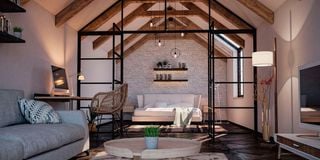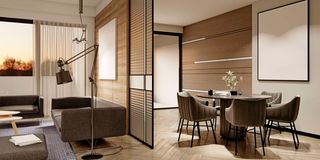Premium
5 smart ways to divide a room to make it serve more than one function

You have spaces that, if divided smartly, can serve more than one function. One of the age-old ways to divide a room has been to use a curtain. Or sheers. Unfortunately, this can appear tacky and suspicious.
What you need to know:
- You have spaces that, if divided smartly, can serve more than one function.
- One of the age-old ways to divide a room has been to use a curtain. Or sheers.
- Unfortunately, this can appear tacky and suspicious.
Imagine that you live in what they call a studio apartment. It is one spacious expansive room that doubles up as your living room, bedroom, dining room and home office.
Or you have a bedroom where you have converted a corner into your working-from-home office. Or a spare bedroom where you iron and fold your clean laundry but also where your toddlers can play.
Or you have a second living room that can also be your home bar, or your lounge, perhaps both.
Basically, you have spaces that, if divided smartly, can serve more than one function.
One of the age-old ways to divide a room has been to use a curtain. Or sheers. You screw on a curtain rod or curtain rail from one side of the room to the other, puncture some eyes into your curtains or sheers, and hang it up, creating two distinct spaces for distinct functions.
Unfortunately, this can appear tacky and suspicious. Also, that gesture of sweeping a curtain aside to move from this space to that space can make you feel like a performer on the set of a theatre production.
It also seems a bit odd to walk into a curtain floating about unexpectedly. Forget the curtain, therefore, and consider these five stylish ways to divide a room:
1. Room divider
The go-to stylish option for dividing a room is to use a foldable and movable room divider. A room divider is a panel screen made from materials such as faux wood, fabric, plastic or any other lightweight material that can be folded and moved about.
Room dividers are as functional as they are aesthetic. Get one that picks your home's colours, materials and general styling palette. Also, pay attention to its height and its width: some dividers are so small they barely offer any privacy, get one with at least four panels.
Room dividers must be handled with great care as the folding-and-opening mechanism can sometimes come apart, rendering the entire thing useless. Room dividers are very versatile and can be used in any space in the home.
2. Shelving unit
I have purposefully used the term ‘shelving unit’, not ‘book shelf’ because of the form and style of a shelving unit.
The shelving unit that can be used as a room divider has shelves of different heights. The ones that have geometric compartments are quite appealing for the home, more so if these compartments are asymmetric.
Get the ones that are not closed off at the back, as they will make your space seem more open than it is.

The go-to stylish option for dividing a room is to use a foldable and movable room divider. A room divider is a panel screen made from materials such as faux wood, fabric, plastic or any other lightweight material that can be folded and moved about.
For height, let it go as close to the ceiling as you can. This creates another illusion. Display on your shelving unit as many interesting accessories as you like: photo frames and faux potted plants, books and statuettes, and pretty much anything that tickles your fancy. Switch them up often to maintain interest. Shelving units are best for dining and living rooms.
3. Half wall
You can also divide space using a half-wall. A half-wall is basically just that: the top surface can be used as a table, a display shelf, a home bar, a coffee table… pretty much anything you feel like. A half-wall can be built from gypsum or from wood, anything that can be demolished when called upon. You can line the top with materials such as granite, good-old ceramic tiles, natural wood or even glass.
The height can be the standard table height or the standard bar height, it will depend on what you are after.
You can also install a shelving unit above your half wall, this truly divides up the space and closes off the distinct sections.
Another option is to install some display shelves on the wall itself: this limits its functions and costs more money but also gives you a styling opportunity.
Half walls are ideal for dividing the kitchen from the living/dining room.
4. Rugs
Rugs are a quick and budget-friendly option for dividing up a room. Have two separate rugs for two distinct sections of one space. Make sure that the rugs are contrasting but complementing, that they are not overlapping, and that there is some bare floor between them that is visible when someone is standing there. Also, make sure they are not bunched up against the walls.
Style each section of the two area rugs with its own distinct furniture. You can go for the open-plan styling but make sure that from no two sides do you look straight at the back of the furniture – this tells the mind that the area is closed off. It also makes the space seem smaller than it actually is. Open-plan styling opens up the space some more.
Rugs serve best as dividers in small spaces that don’t ask a lot from you.
5. Colours and textures
The last way to divide a room is to paint the walls of each space – yet again – in a distinct contrasting yet complementing colour. Where one colour ends, the other begins – this will also tell the mind that where one function ends, another begins. If you have the budget, you can also do the same with the flooring materials.
Ceramic tiles for one space, wooden tiles for another. Or just have ceramic tiles but in different styles and textures for each distinct section.
Distinct colours and textures work best in creating cosy nooks in your home - say, a dining room in your kitchen, a reading nook in your bedroom or even a conversational nook in your living room.
[email protected]; @_craftit





